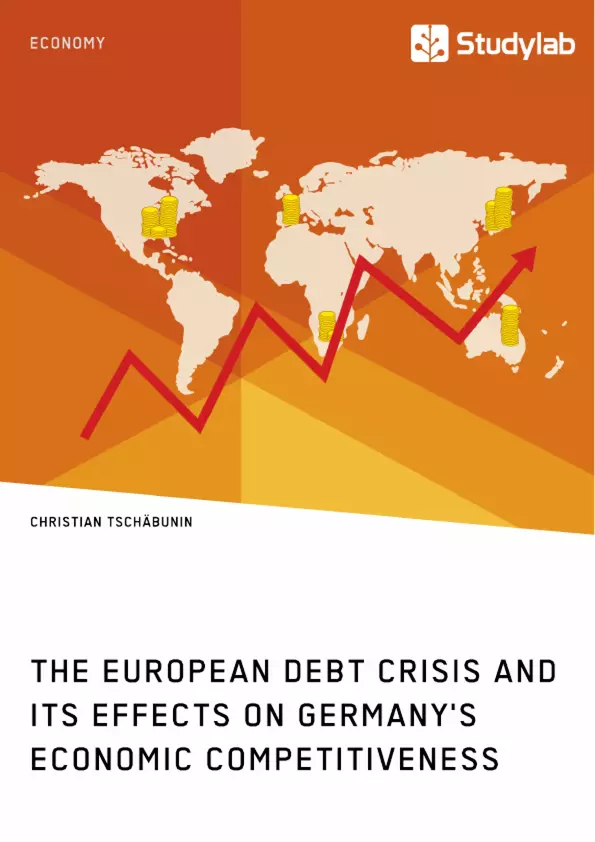For Germany, as a strongly export-oriented economy, competitiveness on the international markets is of critical importance for its wealth and economic growth. A loss of competitive advantages could therefore severely affect the German economy. The aim of this book is to answer the question if and in what way this threat affected Germany’s economic competitiveness during the European debt crisis. The results will then be used to further define the publicly dominant disadvantages as well as possible advantages for Germany as a consequence of the crisis. In the end, the book also has the objective to give policy recommendations for the euro crisis from a German perspective. The results can subsequently contribute to the discussion whether Germany’s current policy is really „without any alternative“.
In order to achieve the overall research goal, a combination of literature review and comprehensive data analysis is used. First of all, to provide a first „pillar“ of contextual background for the following analysis, an overview of the development and causes of the European debt crisis is given by referring to existing literature. Also, this section presents the financial and economic consequences of the described events in a graphical manner. Secondly, to construct the second pillar of conceptual framework, the term „economic competitiveness” is defined by a comprehensive literature review.
Emphasis is put upon the concept of „ability to sell” and the measurement method of the country rankings while a short overview of other concepts is also provided. Finally, in combining theory and practice, an in-depth data-based analysis of the development of Germany’s economic competitiveness is given. With the help of various publicly available data sources, Germany’s ability to sell and other competitiveness metrics are tracked and elaborated on over the last centuries, with a special emphasis on the timeframe of the European debt crisis. Furthermore, comparisons to other countries are made to emphasize characteristics unique to Germany. Ultimately, the results of the analyses are evaluated and concluded in a short discussion about Germany’s current policy in the euro crisis.
In this book:
- the European debt crisis;
- the role of Germany;
- competitiveness;
- prosperity;
- ability to sell
Inhaltsverzeichnis (Table of Contents)
- Abkürzungsverzeichnis
- 1 Introduction
- 1.1 Motivation, Research Question and Objective
- 1.2 Structure of the Work and Methodological Approach
- 2 The European Debt Crisis: Development, Causes and the Role of Germany
- 2.1 Evolution of the European Debt Crisis
- 2.2 Causes of the Crisis and the EU's Recovery Strategy
- 2.3 The Euro Crisis' possible influence on Germany's competitiveness
- 3 Economic Competitiveness as an Indicator for a Country's Prosperity
- 3.1 Different Approaches to the Term “Competitiveness”
- 3.2 Ability to Sell as a Measure of Competitiveness
- 3.3 Country Rankings as an Alternative Indicator for Competitiveness
- 4 Germany's Competitiveness Indicators in the Context of the Euro Crisis
- 4.1 Assessment of Unit Labour Costs
- 4.2 Assessment of Real Effective Exchange Rates
- 4.3 Assessment of the Current Account Balance
- 4.4 Assessment of the Global Competitiveness Index
- 5 Conclusive Implications
- 5.1 How has Germany's competitiveness been affected by the Euro crisis?
- 5.2 Limitations of the Study and Suggestions for Further Research
- 5.3 Conclusion and Policy Recommendations for Germany
- 6 Reference List
- 7 Appendix
Zielsetzung und Themenschwerpunkte (Objectives and Key Themes)
This work aims to analyze the effects of the European debt crisis on Germany's economic competitiveness. The study examines the development and causes of the crisis, focusing on the role of Germany and its potential influence on German economic performance. It investigates various indicators of competitiveness, including unit labor costs, real effective exchange rates, current account balance, and the Global Competitiveness Index, to assess their performance in the context of the Euro crisis.
- The European debt crisis and its impact on Germany's economy.
- The role of Germany in the crisis and its response to the challenges.
- Analysis of key competitiveness indicators for Germany in the context of the crisis.
- Evaluation of the effectiveness of policies implemented to address the crisis.
- Implications for future economic development and policy recommendations for Germany.
Zusammenfassung der Kapitel (Chapter Summaries)
- Introduction: This chapter introduces the research topic, outlines the motivation behind the study, and presents the research question and objective. It also provides an overview of the structure and methodology employed in the work.
- The European Debt Crisis: Development, Causes and the Role of Germany: This chapter delves into the development of the European debt crisis, exploring its origins and causes. It examines the role of Germany in the crisis and analyzes the EU's strategy for recovery. The chapter also discusses the potential influence of the Euro crisis on Germany's competitiveness.
- Economic Competitiveness as an Indicator for a Country's Prosperity: This chapter provides a comprehensive understanding of the concept of economic competitiveness. It explores different approaches to defining competitiveness and examines various indicators, such as the ability to sell and country rankings, used to measure it.
- Germany's Competitiveness Indicators in the Context of the Euro Crisis: This chapter analyzes key competitiveness indicators for Germany in the context of the Euro crisis. It examines unit labor costs, real effective exchange rates, current account balance, and the Global Competitiveness Index, assessing their performance and potential impact on German economic competitiveness.
Schlüsselwörter (Keywords)
The primary keywords and focus topics of this work include European debt crisis, Euro crisis, German economic competitiveness, unit labor costs, real effective exchange rates, current account balance, Global Competitiveness Index, structural reforms, financial austerity, Keynesian economics, and the role of Germany in the European Union.
- Quote paper
- Christian Tschäbunin (Author), 2017, The European debt crisis and its effects on Germany's economic competitiveness, Munich, GRIN Verlag, https://www.grin.com/document/369619



